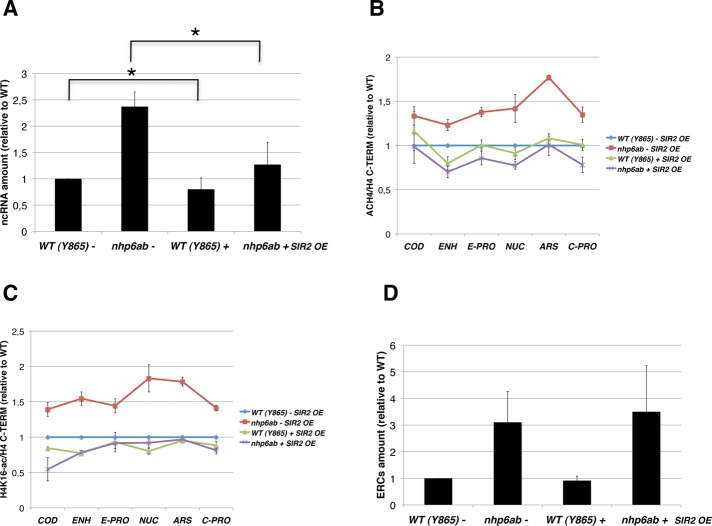FIGURE 8:
SIR2 overexpression restores the WT level of ncRNA transcription and H4 acetylation in the nhp6ab mutant. (A) SIR2 overexpression in the nhp6ab mutant restores the levels of ncRNA transcription. WT and nhp6ab cells were transformed with the pAR44 plasmid (+) or with the empty vector (–). Quantification of ncRNA expression was performed as described in Figure 3 (n ≥ 4; ±SD). Two-tailed t test was applied for statistical analysis. Asterisks indicate the statistically relevant differences between nhp6ab cells with or without SIR2 overexpression (α = 0.01; p = 0.0015) or between WT cells with or without SIR2 overexpression (α = 0.01; p = 0.009). (B) SIR2 overexpression rescues the altered histone H4 acetylation of the nhp6ab mutant. Cells overexpressing (+) or not (–) SIR2, were grown in galactose and processed for ChIP analysis with antibodies against the C-terminal tail of histone H4 or against the acetylated histone H4 (ACH4). Quantification details and positions of PCR fragments are as in Figure 4. (C) The increased H4K16 acetylation of nhp6ab drops to the WT level after SIR2 overexpression. As in B, except that the antibodies were anti–acetyl histone H4-Lys-16 (H4K16-ac) and anti–H4 C-terminal tail (H4 C-TERM). (D) SIR2 overexpression does not reduce the ERC levels in the nhp6ab strain. DNA from cells containing the PAR44 plasmid (+) or the empty vector (–) was extracted and processed for ERC analysis as described in Figure 2 (n = 3; ±SD).

